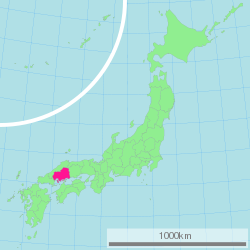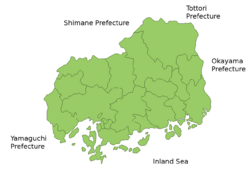Hiroshima Prefecture
| Hiroshima Prefecture | |||||||||
|
|||||||||
 |
|||||||||
| Capital | Hiroshima | ||||||||
| Region | Chūgoku | ||||||||
| Island | Honshū | ||||||||
| Governor | Yuzan Fujita | ||||||||
| Area (rank) | 8,476.95 km² (11th) | ||||||||
| - % water | 0.3% | ||||||||
| Population (October 1, 2000) | |||||||||
| - Population | 2,878,915 (12th) | ||||||||
| - Density | 340 /km² | ||||||||
| Districts | 5 | ||||||||
| Municipalities | 23 | ||||||||
| ISO 3166-2 | JP-34 | ||||||||
| Website | http://www.pref.hiroshima.lg.jp | ||||||||
| Prefectural Symbols | |||||||||
| - Flower | |||||||||
| - Tree | Japanese maple (Acer palmatum) | ||||||||
| - Bird | Red-throated diver (Gavia stellata) | ||||||||
Symbol of Hiroshima Prefecture |
|||||||||
| Template ■ Discussion ■ Parameter ■ WikiProject Japan | |||||||||
Hiroshima Prefecture (広島県 Hiroshima-ken?) is a prefecture of Japan located in the Chūgoku region on Honshū island. The capital is the city of Hiroshima.
Contents |
History
The area around Hiroshima, formerly divided into Bingo and Aki provinces, has been a center of trade and culture since the beginning of Japan's recorded history. Hiroshima is a traditional center of the Chūgoku region and was the seat of the Mori clan until the Battle of Sekigahara.
Hiroshima is home to two UNESCO World Heritage sites:
- the Atomic Dome in Hiroshima, one of the few remnants of prewar Hiroshima following the atomic bombing in 1945;
- Itsukushima Shrine in Miyajima, famed for filling with water and appearing to "float" during high tide.
Located on the island of Okunoshima (city of Takehara), are the remains of a toxic gas factory linked to Unit 731.[1] Different types of chemical weapons were produced there during the first part of the Shōwa era like mustard gas, yperite, lewisite and cyanide.[2] These weapons were used against Chinese soldiers and civilians and during the experiments on humans by Shiro Ishii's units. [3]
Geography
Hiroshima prefecture lies in the middle of Chūgoku, facing Shikoku across the Seto Inland Sea. Most of the prefecture consists of mountains leading towards Shimane Prefecture, but rivers produce rich plains near the coast, and the prefecture also includes many small islands in the Inland Sea. The sheltered nature of the Inland Sea makes Hiroshima's climate very mild.
Cities
Fourteen cities are located in Hiroshima Prefecture:
|
|
|
Towns and villages

These are the towns and villages in each district:
|
|
|
Mergers
Economy
Hiroshima's main industries include automobiles (Mazda is headquartered in Hiroshima Prefecture) and shipbuilding (Kure was one of the main naval bases of the Imperial Japanese Navy and remains a major commercial yard).
Culture
Sports
The sports teams listed below are based in Hiroshima.
Football(soccer)
- Sanfrecce Hiroshima (Hiroshima city)
Baseball
- Hiroshima Toyo Carp (Hiroshima city)
Volleyball
- JT Thunders (Hiroshima city)
Tourism
|
|
External links
- Official Hiroshima Prefecture homepage
- Life in Hiroshima and other Japan-related Articles
- Hiroshima Weather Forecast
- National Archives of Japan ... Hiroshima map (1891)
- National Archives of Japan: Itsukushima kakei, illustrated scroll describing Itsukushima, text by Kaibara Eiken (circa 1720)
|
|||
| Cities | |||
|---|---|---|---|
| Akitakata | Etajima | Fuchū | Fukuyama | Hatsukaichi | Higashihiroshima | Hiroshima (capital) | Kure | Mihara | Miyoshi | Onomichi | Ōtake | Shōbara | Takehara | |||
| Districts | |||
| Aki | Jinseki | Sera | Toyota | Yamagata | |||
|
|
|||||||||||